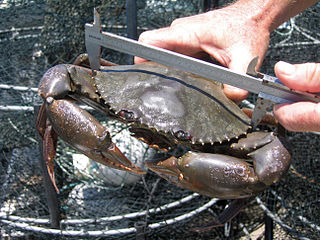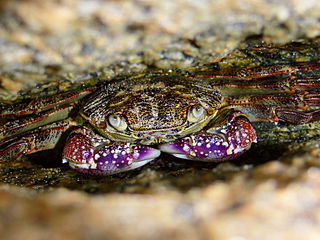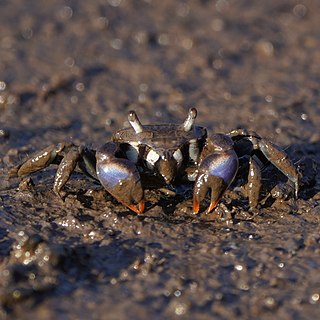
Scylla serrata is an ecologically important species of crab found in the estuaries and mangroves of Africa, Australia, and Asia. In their most common forms, their shell colours vary from a deep, mottled green to very dark brown.

Ocypode is a genus of ghost crabs found in the sandy shores of tropical and subtropical regions throughout the world. They have a box-like body, thick and elongated eyestalks, and one claw is larger than the other in both males and females. They inhabit deep burrows in the intertidal zone. They are primarily nocturnal, and are generalist scavengers and predators of small animals. The genus contains 21 species.

Tuerkayana hirtipes is a species of terrestrial crab.

Leptograpsus variegatus, known as the purple rock crab, is a marine large-eyed crab of the family Grapsidae, found in southern subtropical Indo-Pacific Oceans. It grows to around 50 millimetres (2.0 in) shell width. It is the only species in the genus Leptograpsus.

The red rock crab, Guinusia chabrus, is a marine large-eyed crab of the family Plagusiidae. It is found in the southern Indian and southern Pacific Oceans, including South Africa, Australia, New Zealand, and Chile.

Plagusia squamosa is a marine crab of the family Plagusiidae, formerly considered a subspecies of Plagusia depressa. It is found in tropical Indo-Pacific oceans. P. squamosa's carapace is bumpy and quite coarse, seemingly scaly, leading to its common name: The Scaly Rock Crab.

Dardanus pedunculatus, commonly referred to as the anemone hermit crab, is a species of hermit crab from the Indo-Pacific region. It lives at depths of up to 27 m and collects sea anemones to place on its shell for defence.

Heloecius cordiformis is a species of semiterrestrial crab found in mangrove swamps and mudflats along the east coast of Australia. Adults are around 25 mm (1 in) wide, with males being larger and having larger and more conspicuously coloured claws. The males wave their claws to communicate with other crabs, giving them their common name of semaphore crab. They can breathe both in air and under water, and feed at low tide on detritus in the sediment. H. cordiformis is the only species in the genus Heloecius and the family Heloeciidae.

Mictyris longicarpus, the light-blue soldier crab, is a species of crab that lives on sandy beaches from the Bay of Bengal to Australia; with other members of the genus Mictyris, it is "one of the most loved crabs in Australia". Adults are 25 mm (1 in) across, white, with blue on their backs, and hold their claws vertically. They feed on detritus in the sand, leaving rounded pellets of discarded sand behind them. The males may form into large "armies" which traverse the beach at low tide, before the crabs dig into the sand to wait for the next low tide.

Dromia dormia, the sleepy sponge crab or common sponge crab, is the largest species of sponge crab. It grows to a carapace width of 20 cm (8 in) and lives in shallow waters across the Indo-Pacific region.

Hemigrapsus is a genus of varunid crabs comprising thirteen species native almost exclusively in the Pacific Ocean, but two have been introduced to the North Atlantic region.

Oregonia is a genus of crabs, comprising two extant species and one fossil species: It is classified in the family Oregoniidae under the spider crab superfamily Majoidea.

Atergatis floridus, the floral egg crab, green egg crab, pancake crab, or shawl crab, is a species of tropical Indo-Pacific crab from the family Xanthidae. The meat of this crab is toxic, even if cooked, and consumption often results in death.

Australoplax tridentata, commonly known as the furry-clawed crab or tuxedo shore crab is a species of crab in the family Macrophthalmidae that is found in Queensland, New South Wales and the Northern Territory.

Pseudohelice subquadrata is a species of crab in the family Varunidae. It is found from the eastern Indian Ocean to the western Pacific Ocean, north to Japan, south to Eastern Australia, east to French Polynesia, west to Indonesia and Thailand. It lives near mangroves, burrowing in firm soils, firm muddy sand or loose stones. Burrows are towards or above the high tide line on shores of estuaries and near river mouths of bays, and can have offshoots horizontal beneath the surface as long as three metres.

Helopgrapsus haswellianus or Haswell’s shore crab, is the sole species of crab in the genus Helograpsus. It lives in river mouths and bays on the eastern coast of Australia. The carapace is strongly convex with one distinct notch behind the eye. Adult males have larger claws than adult females. The carapace is olive, dark slate grey or reddish. Claws of adult males are orange-yellow. Carapace size is up to 30 mm wide. The orange color is stronger when these crabs live in habitat with lower pollution levels.

Paragrapsus laevis is a species of crab found in south eastern Australia, from southern Queensland to around the South Australian border, including Tasmania.

Macrophthalmus pacificus is a species of sentinel crab found widely across the Indo-West Pacific Ocean, including India, Japan, Malaysia, New Guinea, Solomon Islands, and northern Australia.

Macrophthalmus crassipes is a species of sentinel crab in the family Macrophthalmidae, found around China, Thailand, Malaysia, Australia, and the Caroline Islands. In Australia it is found from north Western Australia through to New South Wales. Common names include the seagrass sentinel crab and the orange spined sentinel crab. On adult males there is a substantial tooth on the lower claw and a much smaller tooth on the upper claw, and noticeable orange spines on the “wrist” (carpus) of the clawed leg and on the palm of the clawed leg. The carapace is covered in small granules, and is up to around 37 mm (1.5 in) across. It is a burrowing crab, and lives in open tidal flats, muddy or with sandy mud, low on tidal creek banks, and adjacent mangroves.

Tubuca coarctata is a species of fiddler crab found in the western Pacific ocean, including Japan, Taiwan, the Philippines, Indonesia, New Guinea and Australia. The common name of these crabs is either the compressed fiddler crab, or the orange-clawed fiddler crab,. They are found on tidal mud flats adjacent mangroves and muddy tidal creek and river banks.





















